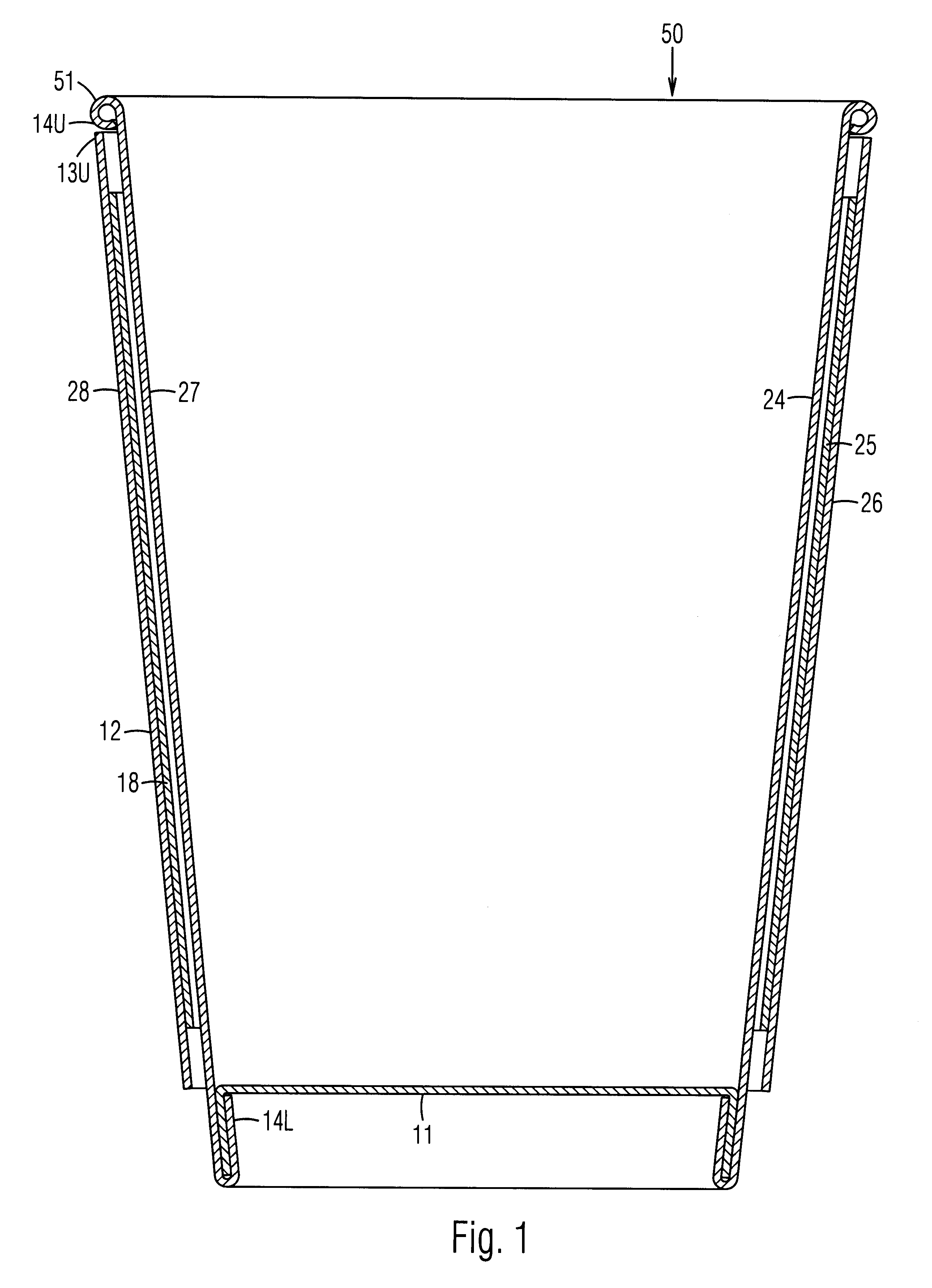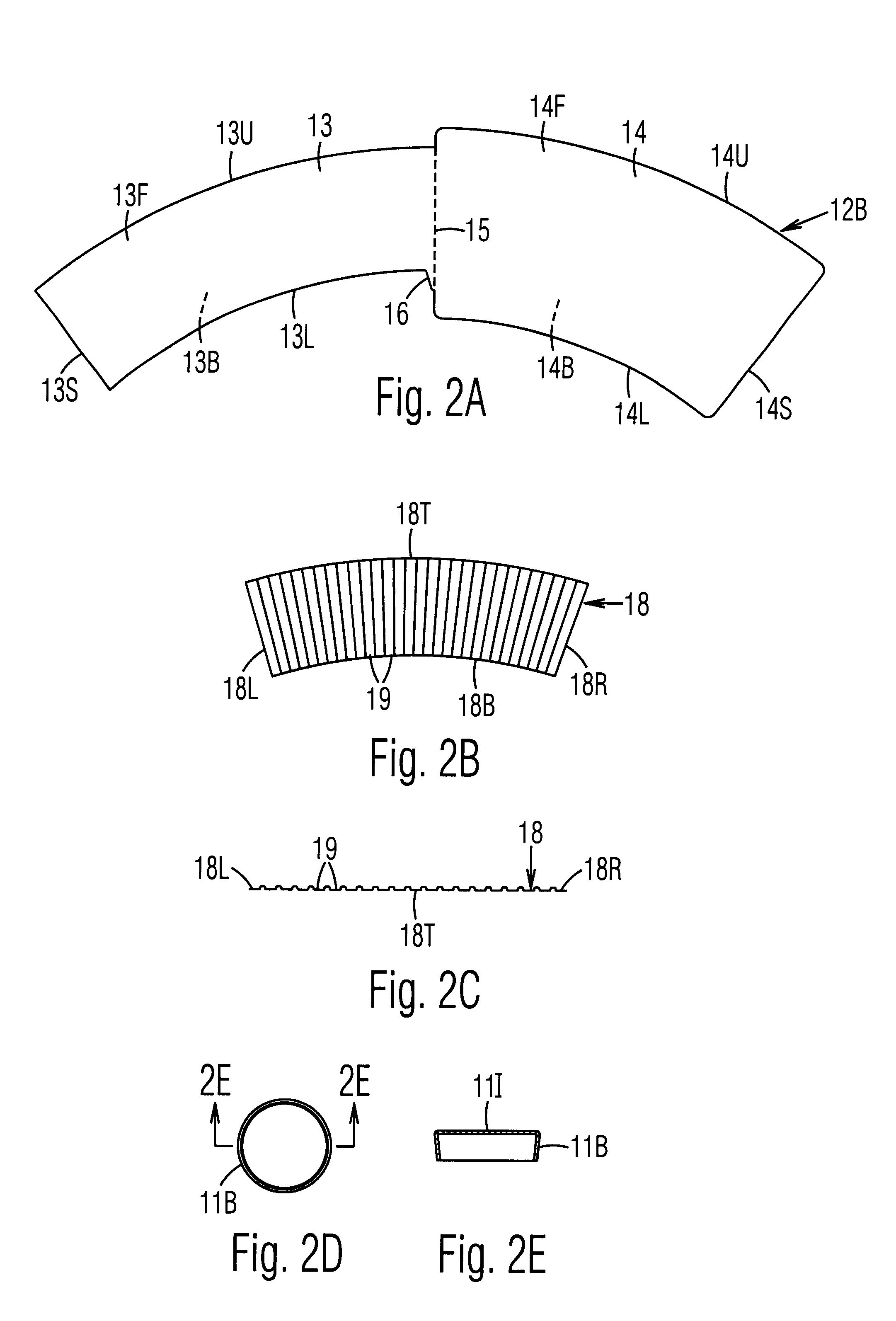Insulated cup and method of manufacture
a technology of insulated cups and cups, which is applied in the field of disposable cups or containers, can solve the problems of cup wet, cold, and uncomfortable use for prolonged periods of time, and achieves the effects of reducing and increasing the number of disposable cups
- Summary
- Abstract
- Description
- Claims
- Application Information
AI Technical Summary
Problems solved by technology
Method used
Image
Examples
first embodiment
In accordance with the invention a cup or container (FIG. 1), includes bottom 11 and a sidewall 12. The bottom is formed from a bottom blank 11B (FIGS. 2D and 2E).
Sidewall 12 is formed from sidewall blank 12B (FIG. 2A), which is die cut from a larger sheet or roll (not shown) of paper or other suitable sheet material. The preferable thickness of this material is approximately 0.33 mm (13 mils), but it can be in a range of 0.2 to 0.6 mm (8 to 24 mils). (One mil=0.001 inch.) The blank includes an arc-shaped left section 13, which will form an outer layer of the sidewall, and an arc-shaped right section 14, which will form an inner layer of the sidewall. The two sections border or share a common fold score 15. The purpose of this fold score is to assist in folding the blank along a precise line. Score 15 is preferably formed into sidewall blank 12B at the time that the blank is die cut from the larger starting sheet. However, the score can be formed into blank 12B after the blank is cu...
second embodiment
--Foam Coating for Middle Layer
In a second embodiment, the use of a separate insulating sheet is eliminated entirely. It is replaced with a layer of foam which is coated on sections 13F and / or 14F of blank 12B (FIG. 2A) to produce a paper and foam-coated structure similar to that shown in FIG. 1OB. In order to provide the layer of foam, section 13F (and / or section 14F) of blank 12B is first coated with a layer of thermoplastic synthetic resin film. The thermoplastic synthetic resin is a low-to-medium density polymer. Such a polymer may include (but is not limited to) polyethylene, polyolefin, polyvinylchloride, polystyrene, polyester, nylon and other similar types of materials. I prefer to use a low-density polyethylene. Opposing sections 13B and 14B of blank 12B are coated with a high-density polyethylene film. Next, blank 12B is heat treated at a temperature and for a time sufficient to permit the low density thermoplastic synthetic resin film to foam and form a heat-insulting lay...
third embodiment-- figs.11a to 13b
THIRD EMBODIMENT--FIGS. 11A to 13B
In accordance with a third embodiment, blank 12B and insulating sheet 18 can be replaced with blank 40 (FIG. 11B) to form cup or container 50 (FIG. 1).
Sheet Blanks and Scoring--FIGS. 11A to 11B
Blank 40 (FIG. 11A) is die cut as a single sheet from a larger sheet or roll (not shown) of paper or other suitable sheet material. The preferable thickness of this material is approximately 0.33 mm (13 mils), but it can be in a range of 0.2 to 0.6 mm (8 to 24 mils). Blank 40 is similar to blank 12B (FIG. 2A), except that it has three sections: left section 13, right section 14, and an insulating section 42. Left 13 and right sections 14 share common fold score 15, and are substantially identical to sections 13 and 14 of FIG. 2A. Insulating section 42 (which replaces insulating sheet 18) is connected to section 14 at fold score 41. Section 42 includes upper edge 42U, lower edge 42L, side edge 42S, front side 42F and back side 42B. Sections 13, 14 and 42 will f...
PUM
 Login to View More
Login to View More Abstract
Description
Claims
Application Information
 Login to View More
Login to View More - R&D
- Intellectual Property
- Life Sciences
- Materials
- Tech Scout
- Unparalleled Data Quality
- Higher Quality Content
- 60% Fewer Hallucinations
Browse by: Latest US Patents, China's latest patents, Technical Efficacy Thesaurus, Application Domain, Technology Topic, Popular Technical Reports.
© 2025 PatSnap. All rights reserved.Legal|Privacy policy|Modern Slavery Act Transparency Statement|Sitemap|About US| Contact US: help@patsnap.com



